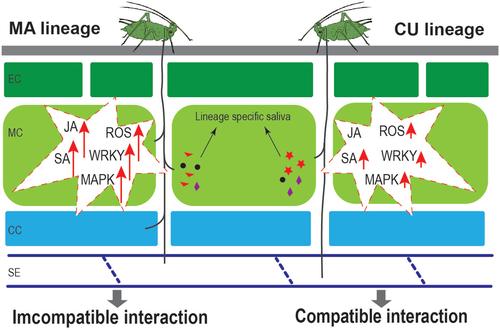当前位置:
X-MOL 学术
›
Pest Manag. Sci.
›
论文详情
Our official English website, www.x-mol.net, welcomes your
feedback! (Note: you will need to create a separate account there.)
Differential activation of defense responses in cucumbers by adapted versus non‐adapted lineages of the cotton‐melon aphid
Pest Management Science ( IF 3.8 ) Pub Date : 2025-01-21 , DOI: 10.1002/ps.8649
Qinglan Yang, Hanwei Kang, Ganxi Ning, Jingjing Feng, Xichen Xiao, Zeyu Wan, James P. Hereward, Yongmo Wang
Pest Management Science ( IF 3.8 ) Pub Date : 2025-01-21 , DOI: 10.1002/ps.8649
Qinglan Yang, Hanwei Kang, Ganxi Ning, Jingjing Feng, Xichen Xiao, Zeyu Wan, James P. Hereward, Yongmo Wang

|
BackgroundThe cotton‐melon aphid, Aphis gossypii Glover, is a polyphagous pest damaging plants across over 100 families. It has multiple host‐specialized lineages, including one colonizing Malvaceae (MA) and one colonizing Cucurbitaceae (CU). The mechanisms underlying these host relationships remain unknown. Here, we compared defensive compounds, gene expressions and aphid susceptibility of cucumbers (Cucumis sativus L.) that were infested with both lineages for up to 14 days.ResultsTotal jasmonic acid (JA) remained constant in CU‐infested cucumbers while increased to a maximum of 19.11 folds at 1 dpi (days post infestation) in MA‐infested cucumbers. Total salicylic acid (SA) increased to a maximum of 4.42 folds at 7 dpi in MA‐infested cucumbers while increased to a maximum of 2.83 folds at 14 dpi in CU‐infested cucumbers. Reactive oxygen species were constantly higher in MA‐infested cucumbers than CU‐infested cucumbers at each time point. Genes involved in defense signaling, for example, MAPKs , PR‐1s , and WRKY , and genes involved in JA and SA biosynthesis, were largely up‐regulated in MA‐infested cucumbers compared with CU‐infested ones. Both lineages exhibited more stylet probing, less phloem ingestion, higher mortality, and less reproduction on MA‐infested cucumbers compared with CU‐infested ones.ConclusionMA lineage aphids elicited stronger defenses in cucumbers than the CU lineage aphids. A lack of salivary effectors specific to cucumbers most likely prevents MA lineage aphids from using cucumbers. Identifying lineage‐specific elicitors or effectors is therefore expected to unveil the molecular mechanisms of host specificity of this aphid. © 2025 Society of Chemical Industry.
中文翻译:

棉瓜蚜虫适应谱系与非适应谱系对黄瓜防御反应的差异激活
背景棉瓜蚜虫 Aphis gossypii Glover 是一种多食性害虫,会破坏 100 多个科的植物。它有多个宿主特化谱系,包括一个定植锦葵科 (MA) 和一个定植葫芦科 (CU)。这些宿主关系背后的机制仍然未知。在这里,我们比较了被两个谱系侵染长达 14 天的黄瓜 (Cucumis sativus L.) 的防御化合物、基因表达和蚜虫敏感性。结果总茉莉酸 (JA) 在 CU 侵染的黄瓜中保持不变,而在 MA 侵染的黄瓜中,总茉莉酸 (JA) 在 1 dpi(侵染后天数)时增加到最大 19.11 倍。在 MA 侵染的黄瓜中,总水杨酸 (SA) 在 7 dpi 时增加到最大 4.42 倍,而在 CU 侵染的黄瓜中,在 14 dpi 时增加到最大 2.83 倍。在每个时间点,MA 侵染的黄瓜的活性氧一直高于 CU 侵染的黄瓜。与 CU 感染的黄瓜相比,参与防御信号传导的基因,例如 MAPK、PR-1 和 WRKY,以及参与 JA 和 SA 生物合成的基因,在 MA 感染的黄瓜中基本上调。与 CU 感染的黄瓜相比,这两个谱系都表现出更多的探针探测、更少的韧皮部摄入、更高的死亡率和更少的繁殖。结论MA 谱系蚜虫在黄瓜中比 CU 谱系蚜虫具有更强的防御能力。缺乏黄瓜特有的唾液效应器很可能会阻止 MA 谱系蚜虫使用黄瓜。因此,鉴定谱系特异性激发子或效应子有望揭示这种蚜虫宿主特异性的分子机制。© 2025 化工学会.
更新日期:2025-01-21
中文翻译:

棉瓜蚜虫适应谱系与非适应谱系对黄瓜防御反应的差异激活
背景棉瓜蚜虫 Aphis gossypii Glover 是一种多食性害虫,会破坏 100 多个科的植物。它有多个宿主特化谱系,包括一个定植锦葵科 (MA) 和一个定植葫芦科 (CU)。这些宿主关系背后的机制仍然未知。在这里,我们比较了被两个谱系侵染长达 14 天的黄瓜 (Cucumis sativus L.) 的防御化合物、基因表达和蚜虫敏感性。结果总茉莉酸 (JA) 在 CU 侵染的黄瓜中保持不变,而在 MA 侵染的黄瓜中,总茉莉酸 (JA) 在 1 dpi(侵染后天数)时增加到最大 19.11 倍。在 MA 侵染的黄瓜中,总水杨酸 (SA) 在 7 dpi 时增加到最大 4.42 倍,而在 CU 侵染的黄瓜中,在 14 dpi 时增加到最大 2.83 倍。在每个时间点,MA 侵染的黄瓜的活性氧一直高于 CU 侵染的黄瓜。与 CU 感染的黄瓜相比,参与防御信号传导的基因,例如 MAPK、PR-1 和 WRKY,以及参与 JA 和 SA 生物合成的基因,在 MA 感染的黄瓜中基本上调。与 CU 感染的黄瓜相比,这两个谱系都表现出更多的探针探测、更少的韧皮部摄入、更高的死亡率和更少的繁殖。结论MA 谱系蚜虫在黄瓜中比 CU 谱系蚜虫具有更强的防御能力。缺乏黄瓜特有的唾液效应器很可能会阻止 MA 谱系蚜虫使用黄瓜。因此,鉴定谱系特异性激发子或效应子有望揭示这种蚜虫宿主特异性的分子机制。© 2025 化工学会.































 京公网安备 11010802027423号
京公网安备 11010802027423号